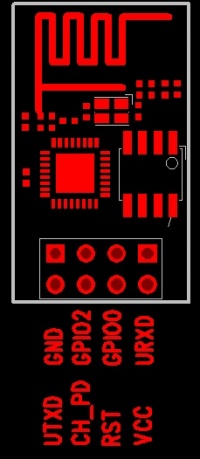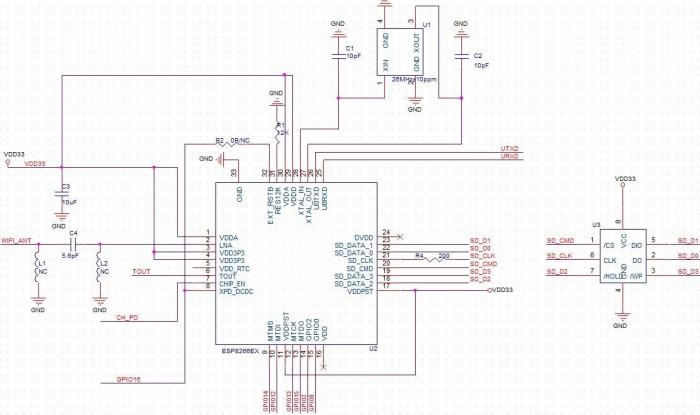Outstanding ESP8266 module
This module has it all, price, performance and a user friendly AT command set that allow you to be up and running immediately.
ESP8266 offers a complete and self-contained Wi-Fi networking solution, allowing it to either host the application or to offload all Wi-Fi networking functions from another application processor.
When ESP8266 hosts the application, and when it is the only application processor in the device, it is able to boot up directly from an external flash. It has integrated cache to improve the performance of the system in such applications, and to minimize the memory requirements.
Alternately, serving as a Wi-Fi adapter, wireless internet access can be added to any microcontroller-based design with simple connectivity through UART interface or the CPU AHB bridge interface.
ESP8266 on-board processing and storage capabilities allow it to be integrated with the sensors and other application specific devices through its GPIOs with minimal development up-front and minimal loading during runtime. With its high degree of on-chip integration, which includes the antenna switch balun, power management converters, it requires minimal external circuitry, and the entire solution, including front-end module, is designed to occupy minimal PCB area.
Sophisticated system-level features include fast sleep/wake context switching for energy-efficient VoIP, adaptive radio biasing for low-power operation, advance signal processing, and spur cancellation and radio co-existence features for common cellular, Bluetooth, DDR, LVDS, LCD interference mitigation.
Note:We have two colors, blue and black, will be shipped randomly
Features:
Electronic Characteristic
1. Current Consumption:
The following current consumption is based on 3.3V supply, and 25℃ ambient, using internal regulators. Measurements are done at antenna port without SAW filter. All the transmitter’s measurements are based on 90% duty cycle, continuous transmit mode.
| Mode | Min | Typ | Max | Unit |
| Transmit 802.11b, CCK 1Mbps, POUT=+19.5dBm | 215 | mA | ||
| Transmit 802.11b, CCK 11Mbps, POUT=+18.5dBm | 197 | mA | ||
| Transmit 802.11g, OFDM 54Mbps, POUT =+16dBm | 145 | mA | ||
| Transmit 802.11n, MCS7, POUT=+14dBm | 135 | mA | ||
| Receive 802.11b, packet length=1024 byte, -80dBm | 60 | mA | ||
| Receive 802.11g, packet length=1024 byte, -70dBm | 60 | mA | ||
| Receive 802.11n, packet length=1024 byte, -65dBm | 62 | mA | ||
| Standby | 0.9 | mA | ||
| Deep sleep | 10 | uA | ||
| Power save mode DTIM 1 | 1.2 | mA | ||
| Power save mode DTIM 3 | 0.86 | mA | ||
| Total shutdown | 0.5 |
uA
|
2.RF Performance
The following are measured under room temperature conditions with 3.3V and 1.1V power supplies.
| Description | Min | Typical | Max | Unit |
| Input frequency | 2412 | 2484 | MHz | |
| Input impedance | 50 | Ω | ||
| Input reflection | -10 | dB | ||
| Output power of PA for 72.2Mbps | 14 | 15 | 16 | dBm |
| Output power of PA for 11b mode | 17.5 | 18.5 | 19.5 | dBm |
| Sensitivity | ||||
| CCK, 1Mbps | -98 | dBm | ||
| CCK, 11Mbps | -91 | dBm | ||
| 6Mbps (1/2 BPSK) | -93 | dBm | ||
| 54Mbps (3/4 64-QAM) | -75 | dBm | ||
| HT20, MCS7 (65Mbps, 72.2Mbps) | -71 | dBm |
Hardware:

Schematic:

Application fields:
AT Commands:
Format
| Set | Inquiry | Test | Execute |
|---|---|---|---|
| AT+<x>=<…> | AT+<x>? | AT+<x>=? | AT+<x> |
| AT+CWMODE=<mode> | AT+CWMODE? | AT+CWMODE=? | - |
| Set the network mode | Check current mode | Return which modes supported | - |
Commands
|
Commands |
Description |
Type |
Set/Execute |
Inquiry |
test |
Parameters and Examples |
|---|---|---|---|---|---|---|
|
AT |
general test |
basic |
- |
- |
- |
- |
|
AT+RST |
restart the module |
basic |
- |
- |
- |
- |
|
AT+GMR |
check firmware version |
basic |
- |
- |
- |
- |
|
AT+CWMODE |
wifi mode |
wifi |
AT+CWMODE=<mode> |
AT+CWMODE? |
AT+CWMODE=? |
1= Sta, 2= AP, 3=both, Sta is the default mode of router, AP is a normal mode for devices |
|
AT+CWJAP |
join the AP |
wifi |
AT+ CWJAP =<ssid>,< pwd > |
AT+ CWJAP? |
- |
ssid = ssid, pwd = wifi password |
|
AT+CWLAP |
list the AP |
wifi |
AT+CWLAP |
|||
|
AT+CWQAP |
quit the AP |
wifi |
AT+CWQAP |
- |
AT+CWQAP=? |
|
|
AT+ CWSAP |
set the parameters of AP |
wifi |
AT+ CWSAP= <ssid>,<pwd>,<chl>, <ecn> |
AT+ CWSAP? |
ssid, pwd, chl = channel, ecn = encryption; eg. Connect to your router: AT+CWJAP="www.electrodragon.com","helloworld"; and check if connected: AT+CWJAP? |
|
|
AT+CWLIF |
check join devices' IP |
wifi |
AT+CWLIF |
- |
- |
|
|
AT+ CIPSTATUS |
get the connection status |
TCP/IP |
AT+ CIPSTATUS |
<id>,<type>,<addr>,<port>,<tetype>= client or server mode |
||
|
AT+CIPSTART |
set up TCP or UDP connection |
TCP/IP |
1)single connection (+CIPMUX=0) AT+CIPSTART= <type>,<addr>,<port>; 2) multiple connection (+CIPMUX=1) AT+CIPSTART= <id><type>,<addr>, <port> |
- |
AT+CIPSTART=? |
id = 0-4, type = TCP/UDP, addr = IP address, port= port; eg. Connect to another TCP server, set multiple connection first: AT+CIPMUX=1; connect: AT+CIPSTART=4,"TCP","X1.X2.X3.X4",9999 |
|
AT+CIPMODE |
set data transmission mode |
TCP/IP |
AT+CIPMODE=<mode> |
AT+CIPSEND? |
0 not data mode, 1 data mode; return "Link is builded" |
|
|
AT+CIPSEND |
send data |
TCP/IP |
1)single connection(+CIPMUX=0) AT+CIPSEND=<length>; 2) multiple connection (+CIPMUX=1) AT+CIPSEND= <id>,<length> |
AT+CIPSEND=? |
eg. send data: AT+CIPSEND=4,15 and then enter the data. |
|
|
AT+CIPCLOSE |
close TCP or UDP connection |
TCP/IP |
AT+CIPCLOSE=<id> or AT+CIPCLOSE |
AT+CIPCLOSE=? |
||
|
AT+CIFSR |
Get IP address |
TCP/IP |
AT+CIFSR |
AT+ CIFSR=? |
||
|
AT+ CIPMUX |
set mutiple connection |
TCP/IP |
AT+ CIPMUX=<mode> |
AT+ CIPMUX? |
0 for single connection 1 for multiple connection |
|
|
AT+ CIPSERVER |
set as server |
TCP/IP |
AT+ CIPSERVER= <mode>[,<port> ] |
mode 0 to close server mode, mode 1 to open; port = port; eg. turn on as a TCP server: AT+CIPSERVER=1,8888, check the self server IP address: AT+CIFSR=? |
||
|
AT+ CIPSTO |
Set the server timeout |
AT+CIPSTO=<time> |
AT+CIPSTO? |
<time>0~28800 in second |
||
|
+IPD |
received data |
For Single Connection mode(CIPMUX=0): + IPD, <len>: |
Download:
Example of Using it
This module has it all, price, performance and a user friendly AT command set that allow you to be up and running immediately.
I was able to communicate with the module right away using an FTDI usb-serial cable, and saw right away that the module has lots of potential!